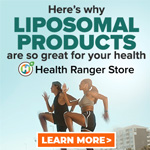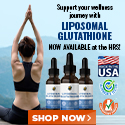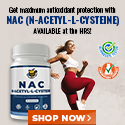
Indoor Air in Homes Often Contaminated with Formaldehyde from Building Materials
 Friday, May 09, 2008 Friday, May 09, 2008by Mike Adams, the Health Ranger Editor of NaturalNews.com (See all articles...) Tags: formaldehyde, health news, Natural News |
- Newly released JFK files reveal Pentagon's role in creating Lyme disease and covid in the same lab
- Discovery of vast underground city beneath Giza pyramids challenges human history
- Black cumin seed oil emerges as a powerful ally against breast cancer and chronic inflammation
- Sugar-free deception: Artificial sweeteners hijack hunger signals, fuel obesity epidemic, study warns
- Catastrophic 7.7 earthquake devastates Myanmar and Thailand; death toll could reach 100,000
- Kiss Your Genetic Privacy Good-Bye! 23andMe Gets Green Light to Sell Your Intimate Genetic Details to Anyone They Want
- AI breakthrough slashes celiac disease diagnosis time from months to minutes
- Europe braces for WAR as EU urges citizens to STOCKPILE FOOD, in latest provocations with Russia
- Aluminum pollution: A silent threat to human health
- Thomas Massie’s Dual Loyalty Disclosure Act aims to restore American sovereignty by cracking down on foreign influence in Congress
- Dr. Suzanne Humphries makes bombshell appearance on Joe Rogan podcast, exposing vaccine industry deception back to POLIOMYELITIS
- The cancer fear industry: How big pharma profits from panic-and what natural alternatives offer
- The mighty Eggplant: An underrated superfood with ancient roots
- 200 Tesla showrooms bracing for Saturday protests as movement against Musk escalates
- Is the vaccine-autism debate reopening? Washington Post sparks controversy with preemptive hit piece on David Geier
- A handful of pecans a day could keep heart disease at bay, study finds
- The great crypto power struggle: How technocrats and governments are reshaping global finance
- Trump administration reportedly preparing for military strikes on Iran, raising fears of escalation
- Newly released JFK files reveal Pentagon's role in creating Lyme disease and covid in the same lab
- Analysis: The coming economic collapse, a mass uprising and Trump's three secret weapons to halt the growing revolt
- Trump nominates VACCINE ZEALOT Susan Monarez to lead the CDC, sidelining RFK Jr.'s reform efforts
- Trump's greatest betrayal so far: Accelerating Middle East wars, silencing dissent, and serving Zionist masters
- Dr. Mike Yeadon releases 15-minute testimony - WATCH - about genocidal intent of COVID “vaccines”
- Festive flavors: The sweet history, nutritional profile and health benefits of pecan pie
- Elon Musk: Aliens could be here on Earth RIGHT NOW
- Big Pharma's $8 Billion bribery scheme exposed: how doctors are pushed to prescribe junk science, not heal
- 5 Simple steps to boost your brainpower: How to strengthen executive function in a distracted world
- Trump reverses course on Gaza plan, says “nobody is expelling Palestinians”
- A lack of integrity in Academia: Harvard professor found GUILTY of fraudulent research to promote CRT theory
- Reclaim your health: How midlife exercise reverses years of inactivity
- Survival 101: Effective EMF blocking techniques
- Florida takes a stand: DeSantis proposes permanent ban on mRNA vaccine mandates
- Sugarcane extract superior to cholesterol-lowering drugs?
- California's social media censorship law struck down: A victory for free speech or a threat to online safety?
- OpenAI whistleblower who dissented against how the company trained ChatGPT found dead
- EPA advisor admits the agency is funneling billions to climate groups ahead of Trump’s return to White House
- EPA advisor admits the agency is funneling billions to climate groups ahead of Trump’s return to White House
- Newly released JFK files reveal Pentagon's role in creating Lyme disease and covid in the same lab
- California's social media censorship law struck down: A victory for free speech or a threat to online safety?
- Dr. Mike Yeadon releases 15-minute testimony - WATCH - about genocidal intent of COVID “vaccines”
- The Health Ranger releases “Vaccine Zombie” song and music video, using AI-animated zombies for the music video
- The pandemic as a tool for INDOCTRINATION: Understanding “The Indoctrinated Brain” by Dr. Michael Nehls
- Florida takes a stand: DeSantis proposes permanent ban on mRNA vaccine mandates
- “Why we influenced the 2020 elections”: Facebook files reveal the coordinated effort to bury the Hunter Biden laptop story
- Mike Adams releases country western hit single: Goin’ Back in Time is Comin’ Home
- Mike Adams releases music poetry sensation: A Child of God
- Unpacking the Lies That We’ve Been Fed – new song and music video released by Mike Adams, the Health Ranger
- Michigan sheriff announces criminal investigation into 2020 election crimes, Dominion Voting Systems
- Migrants are taking advantage of recent hurricanes to scam residents and loot their homes
- House Intelligence Committee calls for the ARREST and PROSECUTION of Dr. Anthony Fauci
- RFK Jr. clears key hurdle: Sen. Susan Collins backs controversial HHS nominee, signaling a new era for health policy
- Rep. Nancy Mace introduces bill to ban biological males from female facilities on federal property
- Peter Rost exposes Big Pharma corruption in his book “The Whistleblower: Confessions of a Healthcare Hitman”
- Mike Adams releases new song and music video: Nothing More Disgusting Than a Globalist
- Red Cross issues warning to stop blood plasma donations from vaccinated people
- Scientists confirm: GENIUS brain function can be spontaneously unleashed in humans without any apparent cause
- EPA advisor admits the agency is funneling billions to climate groups ahead of Trump’s return to White House
- HYSSOP: What research reveals about the health benefits of this ancient holy herb
- Two containers with completed ballots fall out of truck in Florida
- Fully vaccinated about to see “tsunami” of illness and death, warns virologist
- Global leaders unite to clamp down on “misinformation” with UN-backed Cascais Declaration
- BREAKING: 2025 NDAA authorizes mandatory military draft of WOMEN across America… as Pentagon pursues global NUCLEAR war with both Russia and China at the same time
- Michael Yon warns of a ZIONIST TAKEOVER in Trump’s second administration
- BOMBSHELL: DNA testing kits are a SCAM to develop ethnic-specific bioweapons
- Ozempic and Wegovy weight loss drugs are injectable LIZARD VENOM PEPTIDES that may unleash a devastating wave of organ failure… side effects align with symptoms of SNAKE BITES
- Israeli soldiers accused of even more torture and abuse in the West Bank
- These 13 countries just signed an agreement to engineer a global FAMINE by destroying food supply
- NASA admits that climate change occurs because of changes in Earth’s solar orbit, and NOT because of SUVs and fossil fuels
- RFK Jr. clears key hurdle: Sen. Susan Collins backs controversial HHS nominee, signaling a new era for health policy
- Sermon 30: How Jesus reveals Caesar’s FAKE CURRENCY and FALSE AUTHORITY
- Coriander seeds: Ancient medicine backed by modern science
- Arizona officials claim Maricopa County needs 10-13 days to tabulate results of the election
Formaldehyde may be best known for its use as a tissue preservative, such as in the preservation of animals for dissection in schools. It is the chemical's very toxic nature that makes it such an effective preservative: it quickly kills bacteria or fungi that might otherwise begin the process of decomposition. But formaldehyde is also an ingredient in a wide variety of resins used to make permanent adhesives for plywood and carpeting, causing it to be present in furniture and building materials (particularly those made with pressed wood products) and certain molded plastics.
Formaldehyde resins are used to make textiles crease-resistant and can be found in everything from curtains to sheets and clothing. These resins are also used in dishwashing liquids, fabric softeners, carpet cleaners, glues, cardboard and paper products (including wallpaper) and certain latex paints. They are also used in products intended to be used on the body, such as cosmetics (including nail polish and nail hardener) and paper products (facial tissues, napkins and paper towels).
All of these products outgas small quantities of formaldehyde, as do certain insulating foams that are no longer in use in new home construction but that may be present in older homes. Burning of most materials also releases formaldehyde, so fireplaces, wood stoves and smoking can also be a source of indoor formaldehyde.
All buildings are contaminated with formaldehyde
According to Canada's health agency, Health Canada, all buildings in Canada (and presumably the industrialized world) contain low levels of formaldehyde. The agency conducted a study in 2002 and 2003 to measure levels of the contaminant in homes in Ottawa and Prince Edward Island, and found them to vary between 2 and 81 parts per billion (ppb).Formaldehyde is highly toxic in high concentrations -- such as those that might result from a workplace accident -- and carcinogenic in smaller doses. Even in doses below those considered safe for cancer risk, the chemical is still a potent irritant and allergen that can lead to serious health problems.
In toxic concentrations (25,000 ppb or higher), formaldehyde can severely irritate the upper respiratory tract, potentially leading to a swelling or fluid accumulation in the lungs known as pulmonary edema. These symptoms may not manifest until hours after exposure, but can be potentially fatal due to oxygen deprivation. This is not a hazard in normal household exposure, but can be a risk for workers in factories or other workplaces that use formaldehyde.
Cancer and asthma
Formaldehyde has been shown to cause cancer of the nasal tract in humans and laboratory animals and the International Agency for Research on Cancer classifies the substance as a carcinogen (although the U.S. Environmental Protection Agency (EPA) stops short of this, saying only that such an effect is "probable"). According to Health Canada, carcinogenic effects have been detected only at concentrations of thousands of parts per billion, but the International Labor Organization has set 300 ppb as the maximum safe exposure at any given time.Even at the low concentrations found in the average home, formaldehyde can cause potentially serious symptoms. At concentrations above 50 ppb, formaldehyde can irritate the ear, nose and throat. Exposure to such concentrations over time increases the risk of developing asthma-like symptoms, such as wheezing and coughing. At concentrations above 100 ppb, formaldehyde exposure can cause watery eyes, headaches, a burning throat and difficulty breathing, even triggering an asthma attack.
Although there is some controversy about what levels of formaldehyde are most likely to produce serious health symptoms and most homes have concentrations far below the danger threshold, Health Canada still recommends that people reduce their formaldehyde exposure. The EPA has set 16 ppb as the maximum allowable concentration in building to be constructed for the agency.
Health Canada recommends that those wishing to limit their formaldehyde exposure prohibit any smoking in their home, and that they keep all wood-burning appliances well maintained. Fireplaces and wood stoves should be inspected regularly to make sure that no smoke is leaking into the house. Consumers should avoid running any kind of engine near their home, even in a garage or workshop that is attached to the house. Exhaust from automobiles, lawnmowers and other combustion engines contains not only formaldehyde, but other toxic chemicals as well.
Good ventilation will help keep the air in a home safer, particularly if any formaldehyde-containing products are in use. Keeping the humidity low will slow the rate at which such products expel the chemical.
Consumers who decide to buy items made out of fiberboard or particleboard should choose those that are coated with plastic laminate on all sides, or should seal off any still-open sides to prevent formaldehyde from seeping out. The agency recommends shopping for products made without formaldehyde-containing glues. (That's my recommendation as well: Don't buy particleboard furniture at all!)
Finally, all crease-free (permanent press) fabrics, including sheets and clothing, should be washed and aired out before the first use -- or ideally, even before bringing them into the house.
Although formaldehyde gas is colorless, it has a sharp and distinctive odor at high concentrations. Lower concentrations, however, are unlikely to be obviously noticeable. Those concerned about formaldehyde concentrations in their home, school or workplace can buy home testing kits online or from certain distributors.
Formaldehyde in diet soda
Now that you've learned about all the health risks associated with formaldehyde, would you be surprised to learn that millions of consumers are actually drinking it? It's true: Formaldehyde is one of the chemical byproducts of aspartame breakdown in soft drinks. When diet sodas are stored at higher temperature (generally over 95 degrees F), the chemical sweetener aspartame begins to break down, forming small amounts of formaldehyde right in the soda can. When this chemical is swallowed by consumers, it becomes a potent neurotoxin.This explains why aspartame is currently responsible for 75% of all consumer complaints to the FDA. It also explains why diet sodas are linked to seizures, blindness, fuzzy vision, headaches and other neurological disorders.
Want to be healthy? Don't drink formaldehyde. And don't inhale it, either.
Formaldehyde at FETCH.news
Get independent news alerts on natural cures, food lab tests, cannabis medicine, science, robotics, drones, privacy and more.
 About the author:Mike Adams (aka the "Health Ranger") is a best selling author (#1 best selling science book on Amazon.com) and a globally recognized scientific researcher in clean foods. He serves as the founding editor of NaturalNews.com and the lab science director of an internationally accredited (ISO 17025) analytical laboratory known as CWC Labs. There, he was awarded a Certificate of Excellence for achieving extremely high accuracy in the analysis of toxic elements in unknown water samples using ICP-MS instrumentation. Adams is also highly proficient in running liquid chromatography, ion chromatography and mass spectrometry time-of-flight analytical instrumentation.
About the author:Mike Adams (aka the "Health Ranger") is a best selling author (#1 best selling science book on Amazon.com) and a globally recognized scientific researcher in clean foods. He serves as the founding editor of NaturalNews.com and the lab science director of an internationally accredited (ISO 17025) analytical laboratory known as CWC Labs. There, he was awarded a Certificate of Excellence for achieving extremely high accuracy in the analysis of toxic elements in unknown water samples using ICP-MS instrumentation. Adams is also highly proficient in running liquid chromatography, ion chromatography and mass spectrometry time-of-flight analytical instrumentation.
Adams is a person of color whose ancestors include Africans and Native American Indians. He's also of Native American heritage, which he credits as inspiring his "Health Ranger" passion for protecting life and nature against the destruction caused by chemicals, heavy metals and other forms of pollution.
Adams is the founder and publisher of the open source science journal Natural Science Journal, the author of numerous peer-reviewed science papers published by the journal, and the author of the world's first book that published ICP-MS heavy metals analysis results for foods, dietary supplements, pet food, spices and fast food. The book is entitled Food Forensics and is published by BenBella Books.
In his laboratory research, Adams has made numerous food safety breakthroughs such as revealing rice protein products imported from Asia to be contaminated with toxic heavy metals like lead, cadmium and tungsten. Adams was the first food science researcher to document high levels of tungsten in superfoods. He also discovered over 11 ppm lead in imported mangosteen powder, and led an industry-wide voluntary agreement to limit heavy metals in rice protein products.
In addition to his lab work, Adams is also the (non-paid) executive director of the non-profit Consumer Wellness Center (CWC), an organization that redirects 100% of its donations receipts to grant programs that teach children and women how to grow their own food or vastly improve their nutrition. Through the non-profit CWC, Adams also launched Nutrition Rescue, a program that donates essential vitamins to people in need. Click here to see some of the CWC success stories.
With a background in science and software technology, Adams is the original founder of the email newsletter technology company known as Arial Software. Using his technical experience combined with his love for natural health, Adams developed and deployed the content management system currently driving NaturalNews.com. He also engineered the high-level statistical algorithms that power SCIENCE.naturalnews.com, a massive research resource featuring over 10 million scientific studies.
Adams is well known for his incredibly popular consumer activism video blowing the lid on fake blueberries used throughout the food supply. He has also exposed "strange fibers" found in Chicken McNuggets, fake academic credentials of so-called health "gurus," dangerous "detox" products imported as battery acid and sold for oral consumption, fake acai berry scams, the California raw milk raids, the vaccine research fraud revealed by industry whistleblowers and many other topics.
Adams has also helped defend the rights of home gardeners and protect the medical freedom rights of parents. Adams is widely recognized to have made a remarkable global impact on issues like GMOs, vaccines, nutrition therapies, human consciousness.
In addition to his activism, Adams is an accomplished musician who has released over a dozen popular songs covering a variety of activism topics.
Click here to read a more detailed bio on Mike Adams, the Health Ranger, at HealthRanger.com.
Take Action: Support Natural News by linking to this article from your website
Permalink to this article:
Embed article link: (copy HTML code below):
Reprinting this article:
Non-commercial use OK, cite NaturalNews.com with clickable link.
Follow Natural News on Facebook, Twitter, Google Plus, and Pinterest
Science News & Studies
Medicine News and Information
Food News & Studies
Health News & Studies
Herbs News & Information
Pollution News & Studies
Cancer News & Studies
Climate News & Studies
Survival News & Information
Gear News & Information
News covering technology, stocks, hackers, and more



"Big Tech and mainstream media are constantly trying to silence the independent voices that dare to bring you the truth about toxic food ingredients, dangerous medications and the failed, fraudulent science of the profit-driven medical establishment.
Email is one of the best ways to make sure you stay informed, without the censorship of the tech giants (Google, Apple, Facebook, Twitter, YouTube, etc.). Stay informed and you'll even likely learn information that may help save your own life."
–The Health Ranger, Mike Adams













































